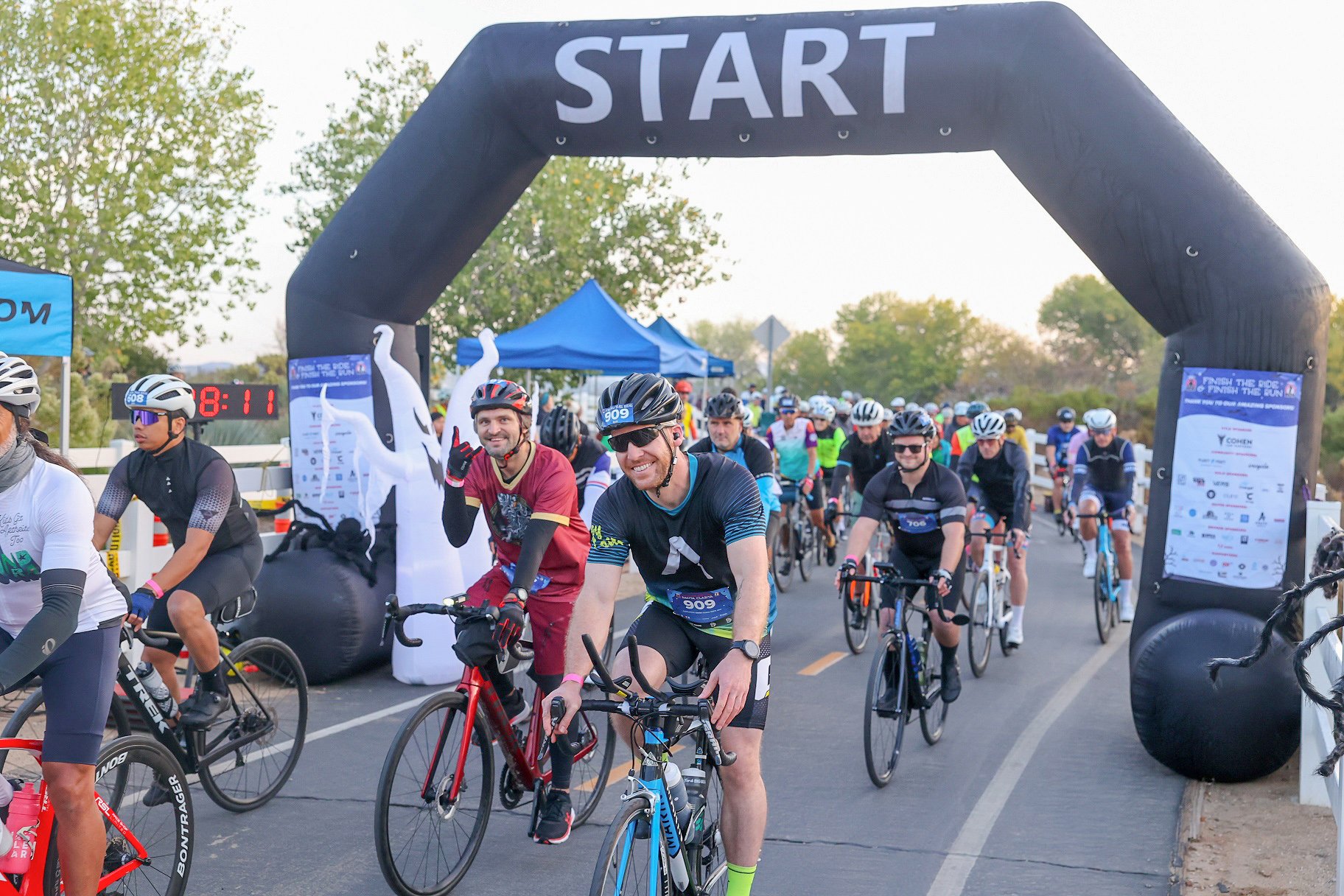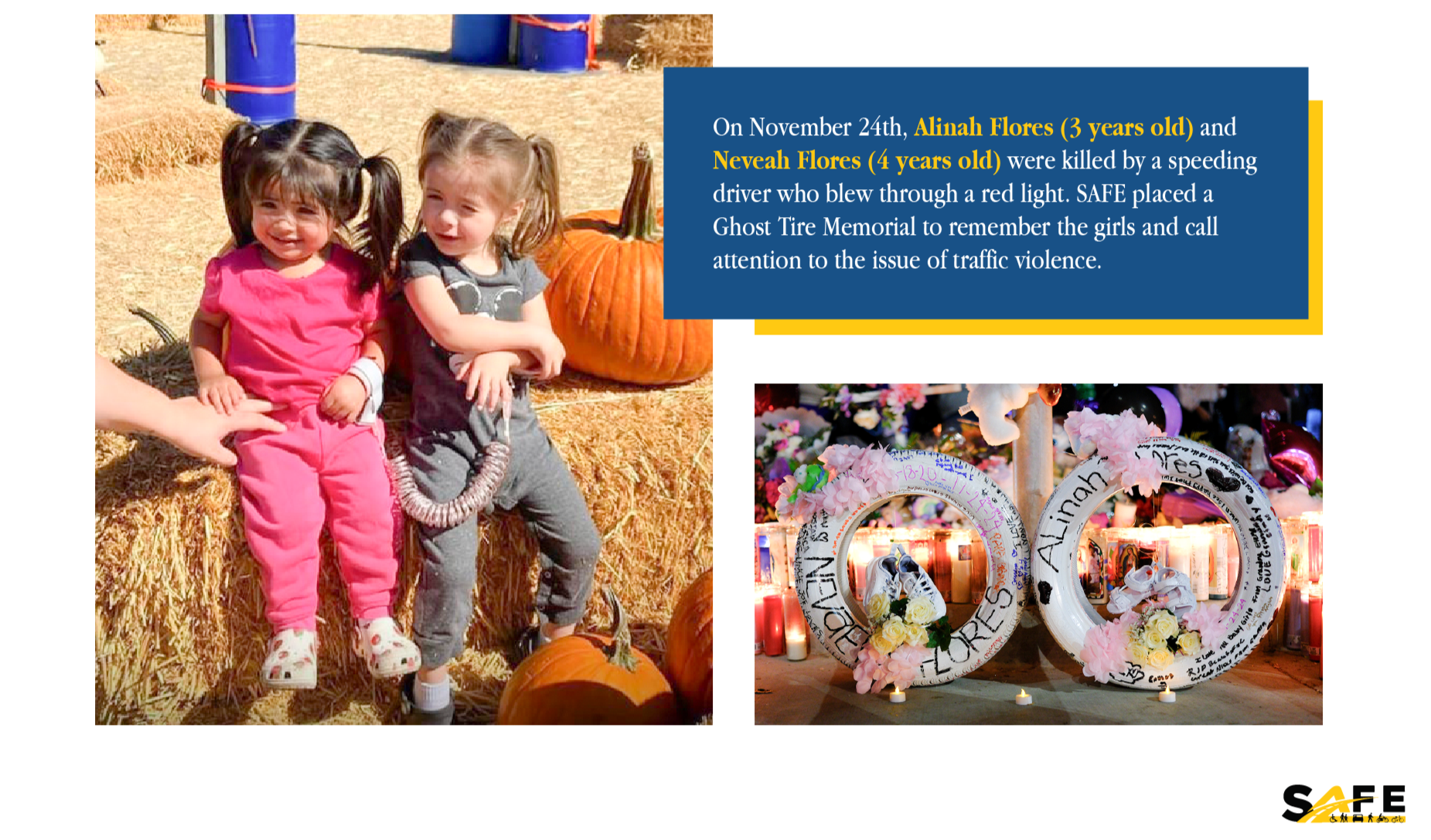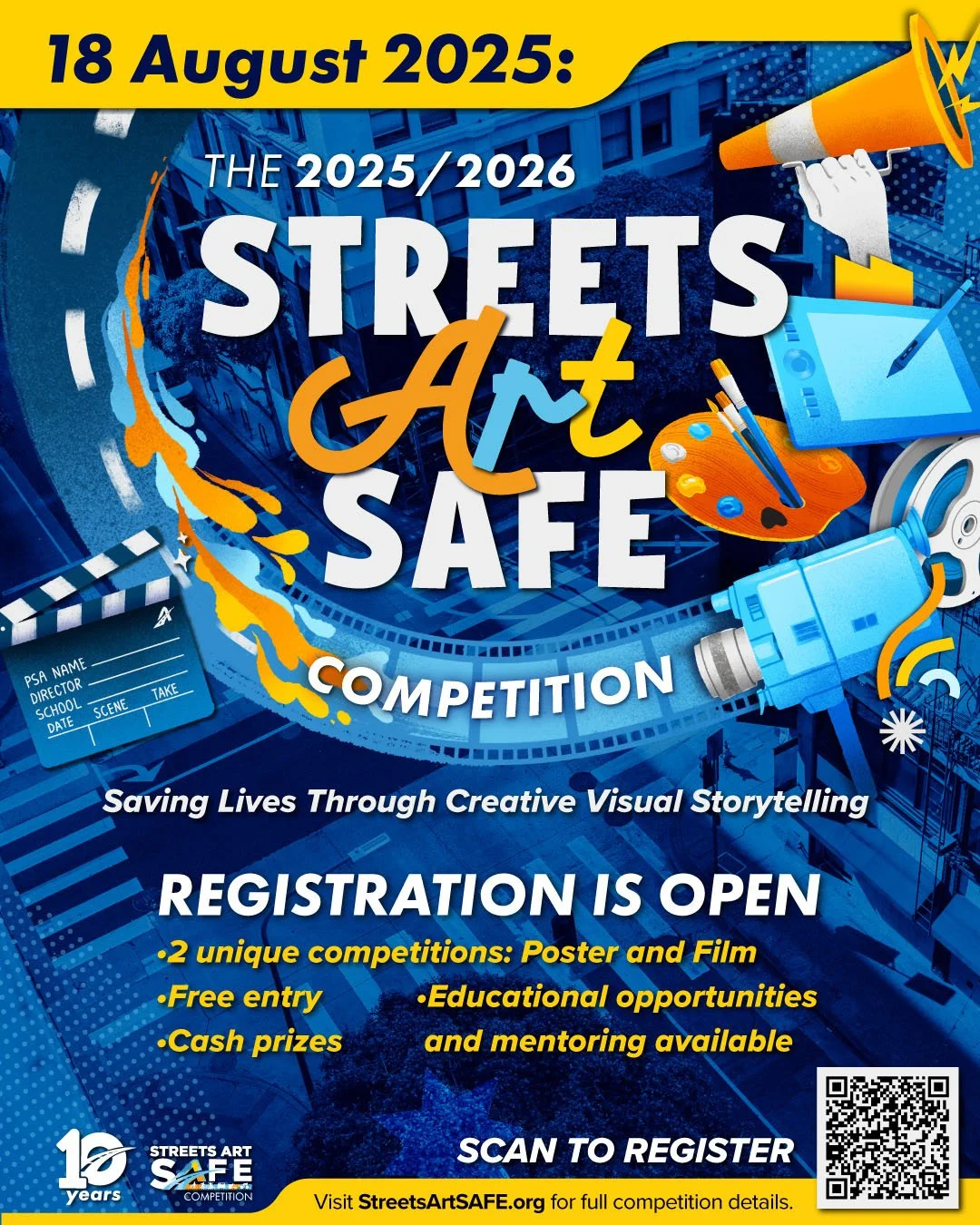The SAFE Streets Blog
AB 645 Speed Safety Systems – Why California Can’t Afford to Wait
Speeding remains one of the leading causes of traffic deaths in California. The Assembly Bill (AB) 645 Speed Safety Systems pilot program was designed to address it head-on. The bill authorizes a five-year pilot program to implement a predetermined number of automated speed cameras across six pilot cities (San Francisco, Oakland, San Jose, Glendale, Los Angeles, and Long Beach), along with Malibu, which was added to the bill a year later. With this program, the state created an opportunity to test a proven, life-saving tool already in use by cities across the nation, such as Seattle, Philadelphia, and New York.
Yet, as of today, implementation progress varies dramatically from city to city, and the delays continue to put the lives of residents and anyone who walks, bikes, or drives in the city at risk.
Coming Together on World Day of Remembrance for Road Traffic Victims
Two people died per day, on average, as a result of traffic violence on Los Angeles County roads in 2024. Connected to those people were countless family members, loved ones, co-workers, and more who are forever impacted by these unnecessary and preventable losses.
For the past seven years, SAFE has commemorated World Day of Remembrance for Road Traffic Victims by telling the stories of those whose lives were cut short and by advocating for meaningful change across the county.
This year, we continued that commitment by honoring the victims, uplifting their families, and pushing for safer streets in every community.
We gathered with partner nonprofit organizations and local and state agencies to honor the 711 people who lost their lives on Los Angeles County roadways in 2024.
PCH Safety Plan: WE DID IT!! Well, almost...
I wanted to announce only good news about this campaign, but the truth is, I have good news and bad news. First, the good news! Thanks to your support, over 350 emails were sent to the City of Malibu, turning a likely defeat at the Planning Commission into a victory.
On Monday, November 4, the Malibu Planning Commission changed its tune and voted 4 to 1 in favor of the Caltrans PCH Safety Project — a $55 million once-in-a-lifetime opportunity to rebuild and make PCH safer for everyone.
Caltrans PCH Safety Project Recap
This plan would repave and reconstruct the western end of PCH from Cross Creek Road to the Ventura County line while adding long-overdue safety improvements like:
Happy Birthday, SAFE!
On Sunday, 14 September, we cheered, we laughed, we cried, we hugged, and we remembered 10 years of advocacy, 10 years of legislation, 10 years of supporting victims of traffic violence, 10 years of road safety education through the arts – 10 years of Streets Are For Everyone. It was a special afternoon, shared with so many friends and family, fellow advocates and supporters.
This is the first time SAFE has held an anniversary event. Technically, SAFE’s official birth, the day the IRS recognized us as a non-profit, is on 3 March 2015. And technically, I should have written and sent this blog out two months ago, but, in our defense (well, it’s more my defense), SAFE has been SOOOO busy with legislation, advocacy, education, and support that it has been hard to find a moment to breathe, let alone plan a celebration or to simply write this blog.
Finish The Ride & Run Santa Clarita 2025: A Halloween Ride with Heart and Purpose
On Sunday, October 26, 861 cyclists, runners, walkers, families, and survivors gathered at West Creek Park for a Halloween-themed Finish The Ride & Run – Santa Clarita, turning a day of fitness into a powerful statement for safer streets across California. The park buzzed with costumes and determination—skeletons, traffic cones, aliens, and even a stunning Catrina brought bursts of color and spirit to the course.
From sunrise to the final medal, the energy was electric and inspiring. Participants of all ages—from 1 to 90—took on the challenge, from the 1K Kids & Puppy Run to the 62-mile Metric Century Ride, proving once again that this iconic LA County event is built on hope, resilience, and community.
Why We Ride and Run
In February 2013, Damian Kevitt’s life changed forever. While cycling in Griffith Park, he was struck by a hit-and-run driver who dragged him nearly a quarter of a mile onto and down the 5 freeway. Against all odds, Damian survived, but he lost his right leg and nearly his life.
As he recovered, Damian made a promise: not only would he finish the ride he started that day, but he would dedicate his life to making streets safer for everyone. That promise became Finish The Ride—a movement that turned tragedy into purpose, pain into momentum, and individual courage into community action.
What Happens When You Stop Driving for a Week?
It’s here! Week Without Driving begins today, and it brings with it an exciting opportunity for all who call Los Angeles home.
For those who don’t drive, this week may not feel like a challenge at all; it’s just everyday life. But for drivers, this week is an invitation: what would it feel like if you put the keys away for seven days?
Maybe you’ve never thought about it. For many, driving feels automatic, even necessary. Yet for others, a car isn’t affordable. Some avoid driving because of stress, while others carry trauma from collisions that make getting behind the wheel impossible. Even more people avoid driving because using other means of travel—walking, biking, or taking transit—is better for mental and physical health and lowers our impact on the planet.
Week Without Driving is a chance to pause and reflect on how our city moves when the car isn’t at the center.
The Hidden Cost of Red Light Running in California — Summary & How to Help
This article summarizes our 25-page Full Report—read the full report here.
Every day, Californians approach intersections trusting that a red light means safety. Yet, for far too many, that trust is shattered in an instant. Red light running has become a silent epidemic across our state—claiming lives, shattering families, and leaving behind an enormous financial burden that few ever stop to consider.
The Hidden Cost of Red Light Running in California — Full Research Report
Traffic collisions are, by and large, preventable. Multiple studies have established this, and it is also recognized by the NHTSA. The fact that we let so many people die year after year due to traffic violence, when we know how people get into traffic collisions, and where they are most likely to get into a traffic collision. We have proven ways to prevent it, which is a testimony to how broken our system is. Nowhere is this more evident than in intersections across California, where hundreds of lives are lost and even more are seriously injured. While a single life lost is tragic, and even more so when it’s entirely preventable, what’s hidden is the cost of these preventable deaths to our communities and the state of California.
Progress on Pearblossom Highway is a Promising Step Toward Safer Roads
On Friday, August 15, 2025, the Pearblossom Highway 138 Safe Roads Initiative team took a significant step forward in our ongoing efforts to improve safety along Pearblossom Highway (PB HWY 138).
Members of our community, along with Assembly member Juan Carrillo and several key decision makers from agencies including CalTrans and LA County Department of Public Works (DPW), came together for a comprehensive, on-the-ground field tour.
A Community Win for Safer Streets in Historic South Central
On April 18, 2024, tragedy struck Historic South Central when 12-year-old Derrick Serrano was hit and killed by a speeding driver at the intersection of Vernon Avenue and Wadsworth Avenue. His loss devastated his family and community and galvanized neighbors into action.
Over the past year, SAFE has partnered with ACCE LA, a grassroots community organization, to demand change at this dangerous intersection and bring awareness to the need for safer intersections across South LA. Together, we organized families and insisted that the city act before another life was lost.
An example of this outspoken advocacy was on April 18th, 2025….
Registration Now Open: The Streets, Art, SAFE Competition Returns for 2025–2026
The wait is over—Streets, Art, SAFE is officially back for the 2025–2026 school year! This free, high school educational program blends art, storytelling, and real-world road safety messages.
Alongside the flagship film and poster competitions, this year brings fresh challenges, expanded learning opportunities, special award categories, new sponsors, and of course, some amazing prizes.
Why the arts? Because when students create film, posters, or Public Service Announcements (PSAs), they’re not just learning about road safety—they’re practicing communication, problem solving, teamwork, and critical thinking. Visual storytelling challenges students to analyze information, distill a message, and express it in a way that connects with others. For teachers, it’s a chance to see students apply their creativity to a real-world issue, building skills in research, writing, media literacy, and the visual arts all at once.
Our Streets, Our Lives: Why South LA Needs Speed Cameras Now
As a pastor who has served South Los Angeles for over 15 years, I’ve seen too much preventable tragedy on our streets. I’ve comforted families who lost loved ones to reckless drivers, and I’ve advocated to city officials to get basic safety measures like pedestrian lights and bus stops for our community.
When my friend Charles Ray was killed in a hit-and-run right here in South LA, I knew I had no choice but to continue demanding better for our community. That’s what brought me to support the push for speed safety systems in Los Angeles, because every day we delay, another family gets an empty chair at their dinner table.
UPDATE: Speed Camera Implementation in So Cal
In 2023, after four years of work, SAFE successfully helped pass AB 645, the California Speed Safety Systems Pilot Program. This groundbreaking policy allows six cities across California—including three in Southern California (Glendale, Long Beach, and the City of Los Angeles)—to pilot speed safety systems designed to reduce speeding and improve conditions on high-injury corridors and in vulnerable areas such as school zones.
What makes AB 645 so groundbreaking is the careful balance built into the law: ensuring the systems effectively slow drivers without being overly burdensome with fines, requiring equitable placement, protecting privacy and transparency, and limiting use to locations where safety improvements are genuinely needed.
Getting Around LA Without a Car
When it comes to first and last mile connections (and let’s be honest, many miles in between), Los Angeles is lacking infrastructure to support non-car users.
Recently, SAFE was copied in an email from Anya McCann, LCI (League of American Bicyclists, League Cycling Instructor), who was visiting LA through LAX and found herself without any Metro bike share options. The email is printed below.
Anya was prepared to bike the few miles from LAX to her destination; she even brought a bicycle helmet. However, the closest station was 4 miles away.
Senate Bill 720 - The Safe Streets Act - On Its Way to Being Signed
Thanks to the support of many advocates, on July 14 and July 16, Senate Bill 720 (SB 720) cleared two major hurdles, passing the Assembly Transportation Committee with a unanimous 15–0 vote, and the Committee on Privacy and Consumer Protection with strong bipartisan support and a 13–2 vote!
SB 720 is designed to bring California’s outdated, failed red light camera law into the modern era, with the goal of saving lives, protecting privacy, increasing transparency, ensuring an equity component, and, most importantly, using the systems only to make intersections safer.
The bill removes the requirement to capture a driver’s face to issue a citation, ensures citations won’t impact your driving record or insurance, and replaces the current steep penalties with a tiered fine structure: starting at $100 and increasing by $100-$150 for repeat violations, up to $500. There is also a mechanism in place for low-income drivers to receive automatic fine reductions.
The bill also ensures that the profit generated from these systems can only be used for safer streets initiatives.
Assembly Bill 1014: Traffic safety: Speed Limits
It was less than two years ago when four Pepperdine University students—20-year-old Niamh Rolston, 21-year-old Peyton Stewart, 21-year-old Asha Weir, and 21-year-old Deslyn Williams—were struck and killed by Fraser Michael Bohm while walking to a mixer at a home along Pacific Coast Highway (PCH) in Malibu, in an area known by locals as “Dead Man’s Curve.”
Bohm was driving at 104 MPH when he lost control of his vehicle, hitting multiple parked cars before striking and killing all four women and injuring two others.
Since 2010, 61 lives have been lost along PCH—a road with a posted speed limit of 45 MPH through residential areas. This speed limit has enabled drivers to frequently exceed 50 or even 60 MPH, creating a deadly environment for pedestrians, cyclists, and other motorists. (Source: LA County Sheriff’s Department and TIMS)
Statewide, speeding remains the leading cause of severe traffic injuries and fatalities in California.
How California Cities Can Save Lives with Assembly Bill 645
California is finally getting serious about making our streets safer. Assembly Bill (AB) 645, a groundbreaking law sponsored by SAFE and passed in 2023, identified six cities to launch a pilot speed safety program in school zones and on dangerous stretches of road where far too many people have been injured or killed. The participating cities are Los Angeles, San Jose, Oakland, Glendale, Long Beach, and the City and County of San Francisco.
Later, Senate Bill 1297 allowed speed safety cameras along the deadly PCH within Malibu city limits as a way to reduce speeding and fatalities on the PCH.
When cities implement speed safety programs under AB 645, they create a powerful cycle of safety that sets this model apart: every camera that catches a speeding vehicle must reinvest the funds it generates directly back into improving safety in that same community.
Streets Are For Everyone Means EVERYONE
At Streets Are For Everyone, our mission is simple: improve the quality of life for pedestrians, bicyclists, and drivers alike by reducing traffic fatalities to zero. This mission does not exclude any Angeleno from our work. We strive to make streets safer for everyone, regardless of their mode of transportation, income, housing status, or immigration status. That means pushing for equitable design, advocating for justice, and demanding infrastructure that protects our most vulnerable neighbors.
Because when we say “Streets Are For Everyone,” we mean everyone.
The ongoing immigrant raids across Los Angeles, including the deployment of 2,000 National Guard troops (and now Marines), did not make the streets safer. In fact, they worked to sow fear and discord across our communities.
Long after this current moment of ICE raids is over, our most vulnerable neighbors will continue to live in fear of moving around the city, of taking the bus, or simply walking down the street.
One Weekend. One Community. One Mission: Safer Streets.
This past 12th annual Finish The Ride and Run Griffith Park was an incredible success, and that’s because everyone showed up to spread not only good energy but also pressure to create a community that is more welcoming to cyclists and runners.
Between riders, runners, volunteers, and spectators, almost 2,000 people were there. And it wasn’t just a crowd—it was a community. That kind of atmosphere only happens when there’s care and intention behind every detail.
Events like this don’t just promote safer streets. They bring people together, offer hope, and show the world what’s possible when a team like ours pours everything into a cause we believe in.




















